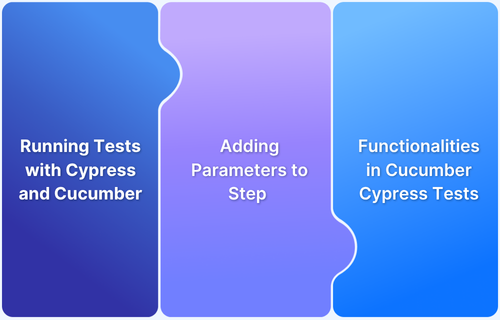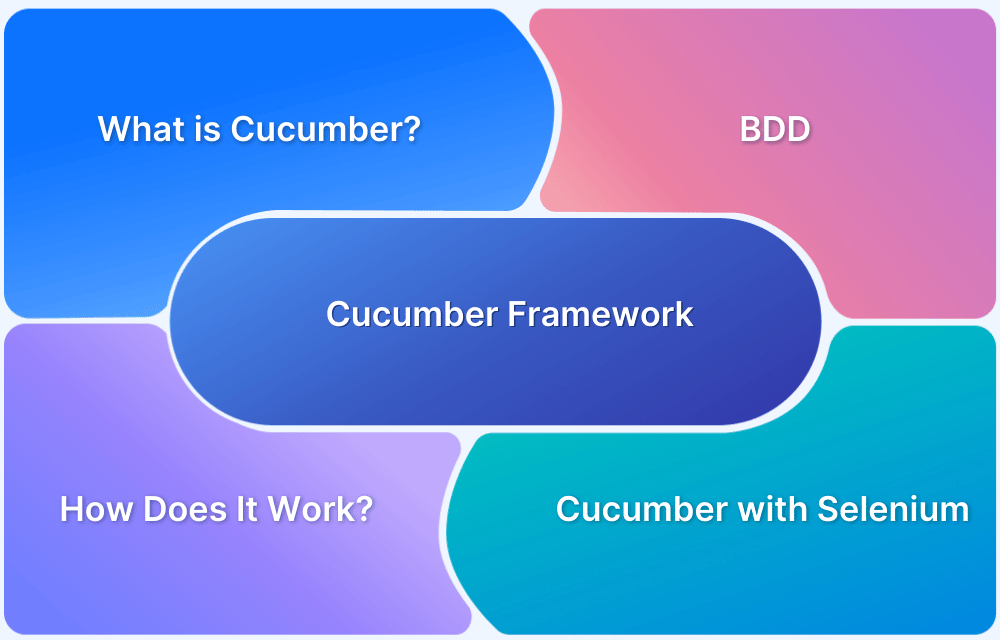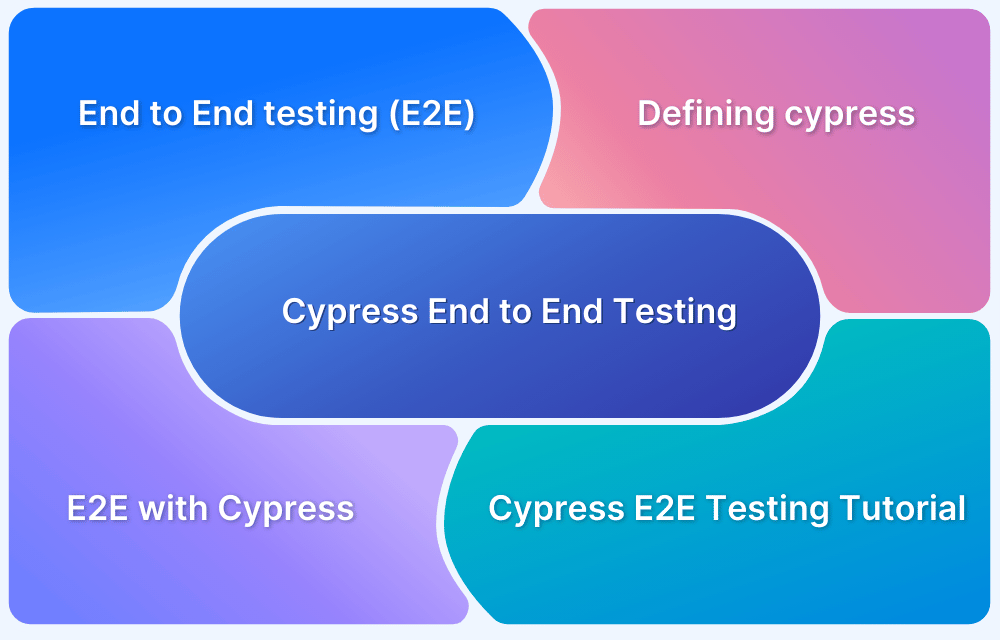Cypress Cucumber Preprocessor lets teams create clear, defined test scenarios that enhance collaboration between developers, testers, and non-technical stakeholders.
Overview
What is Cypress Cucumber Preprocessor?
The Cypress Cucumber Preprocessor is a plugin that lets you use Cucumber-style syntax (Gherkin) in Cypress tests, facilitating Behavior-Driven Development (BDD) with Cypress.
Use Cases of Cypress Cucumber Preprocessor
- Behavior-Driven Development (BDD)
- Structured Test Scenarios
- Separation of Concern
- Test Reusability
- Parallel Test Execution
- Readable Reports
- Cypress Cross-Browser Testing
- Integration with CI/CD
In this article, learn all about the Cypress Cucumber preprocessor in detail, covering its working, uses, configuration and more.
What is Cypress Cucumber Preprocessor?
The Cypress Cucumber Preprocessor is a plugin that lets you use Cucumber-style syntax (Gherkin) in Cypress tests, facilitating Behavior-Driven Development (BDD) with Cypress.
It links the gap between Cypress and Cucumber, enabling you to write test scenarios in Gherkin, define test step definitions in JavaScript or TypeScript and run them with the robust test runner of Cypress.
It lets you write Cypress tests like:
Feature: Login functionality Scenario: User logs in with valid credentials Given the user is on the login page When the user enters valid credentials Then the user should be redirected to the dashboard
Instead of writing tests directly in JavaScript using Cypress commands, you can write test scenarios in plain English using Gherkin syntax (like “Given”, “When”, “Then”). These steps are then connected to JavaScript functions (called step definitions), which contain the actual Cypress code that runs the test.
How Cypress Cucumber Preprocessor work?
- Gherkin Syntax: In feature files, you write your test scenarios using Gherkin syntax. Gherkin is a language that allows you to describe the behavior of your application in a structured, human-readable format. It uses keywords like Given, When, Then, And, and But to define the steps of your test scenarios.
- Step Definitions: Each step in your Gherkin scenario needs to be mapped to JavaScript functions known as “step definitions.” These step definitions contain the test logic that interacts with your web application using Cypress commands.
- Test Execution: When you run your Cypress tests with the Cypress Cucumber Preprocessor, it reads the Gherkin feature files, matches the steps to their respective step definitions, and executes the tests in the browser using Cypress.
- Reporting: Cypress typically generates detailed reports of test execution, and when combined with Cucumber, it provides even more structured and readable reports, making it easier to understand test results.
This approach allows for collaboration between technical and non-technical team members since feature files are written in plain language, making them accessible to stakeholders who may not be familiar with coding. The technical team can then implement the step definitions to make these feature files executable tests.
Uses of Cypress Cucumber Preprocessor
Cypress Cucumber Preprocessor is a powerful tool for writing and executing end-to-end tests using the Cypress testing framework in conjunction with the Cucumber testing framework’s Gherkin syntax. It offers several benefits and use cases:
- Behavior-Driven Development (BDD): We can implement BDD practices in our testing workflow. BDD encourages collaboration between non-technical stakeholders (e.g., product owners, and business analysts) and developers by writing tests in plain language (Gherkin) that everyone can understand.
- Structured Test Scenarios: With Gherkin syntax, we can write test scenarios in a structured and readable format, making it easier to document and communicate the expected behavior of our application.
- Separation of Concerns: It promotes the separation of test scenarios (written in Gherkin) from the actual test code (JavaScript step definitions). This separation makes it easier to maintain and update tests since application behavior changes can be reflected in the Gherkin files without changing the underlying test logic.
- Test Reusability: We can reuse step definitions across multiple test scenarios, reducing duplication and making our test suite more maintainable.
- Parallel Test Execution: Cypress parallel test execution, and when combined with Cypress Cucumber Preprocessor, can run multiple Gherkin scenarios in parallel, speeding up the test execution process.
- Readable Reports: When we run tests using Cypress Cucumber Preprocessor, it generates structured and readable reports that provide clear insights into test results, making it easier to identify issues and failures.
- Cypress Cross-Browser Testing: Cypress supports multiple browsers. We can use Cypress Cucumber Preprocessor to write cross-browser tests in a BDD format, ensuring our application works consistently across different browsers.
- Integration with CI/CD: We can integrate Cypress Cucumber Preprocessor into our CI/CD pipeline, allowing us to automatically run tests whenever code changes are pushed to our repository, ensuring that new changes don’t introduce regressions.
How to install and configure Cypress Cucumber Preprocessor?
Steps to install Cypress Cucumber Preprocessor:
1. Prerequisites
- Ensure you have Node.js and npm (Node Package Manager) installed on your system. You can download and install them from the official website: https://nodejs.org/.
- npm is used for package management, and Cypress plugins are typically distributed as npm packages, making Node.js and npm essential for setup and usage.
2. Create a Cypress Project: You can create one using the following commands:
mkdir my-cypress-project cd my-cypress-project npm init -y
3. Install Cypress: Install latest version of Cypress as a dev dependency in your project:
npm install cypress --save-dev
4. Install Cypress Cucumber Preprocessor: Install Cypress Cucumber Preprocessor latest version (4.3.1) as a dev dependency:
npm install cypress-cucumber-preprocessor --save-dev
5. Create a5. cypress/plugins/index.js File: Create a plugins directory if it doesn’t already exist, and inside that directory, create an index.js file. Add the following code to configure Cypress Cucumber Preprocessor:
const cucumber = require('cypress-cucumber-preprocessor').default;
module.exports = (on, config) => {
on('file:preprocessor', cucumber());
};6. Create Cypress Configuration File: Create a cypress.config.js configuration file in your project root directory:
const { defineConfig } = require('cypress')
module.exports = defineConfig({
'cypress-cucumber-preprocessor': {
nonGlobalStepDefinitions: false,
step_definitions: './cypress/e2e/login/',
},
e2e: {
setupNodeEvents(on, config) {
return require('./cypress/plugins/index.js')(on, config)
},
specPattern: 'cypress/e2e/**/*.feature',
supportFile:false
},
})This configuration tells Cypress to use the Cypress Cucumber Preprocessor for feature files (“testFiles”) and specifies the path to the step definitions (“step_definitions”) directory.
7. Create the test case: Create a Gherkin feature file named login.feature in the cypress/e2e directory with the following content:
Feature: Login to a website Scenario: Successful login Given I open the website When I enter my username "myusername" and password "mypassword" And I click the login button Then I should be logged in
Create a JavaScript file named login.js in the cypress/e2e/login directory with the following content for the step definitions:
import { Given, When, Then, And } from 'cypress-cucumber-preprocessor/steps';
Given('I open the website', () => {
cy.visit('https://example.com'); // Replace with your website URL
});
When('I enter my username {string} and password {string}', (username, password) => {
cy.get('input[name="username"]').type(username);
cy.get('input[name="password"]').type(password);
});
And('I click the login button', () => {
cy.get('button[type="submit"]').click();
});
Then('I should be logged in', () => {
cy.url().should('eq', 'https://example.com/dashboard'); // Replace with the expected URL after successful login
cy.contains('Welcome, User!').should('be.visible'); // Replace with an element or text on the dashboard page
});8. Run Cypress Tests: You can now run your Cypress tests with Cypress Cucumber Preprocessor by using the following command:
npx cypress open
Also Read: How to Run Tests with Cypress and Cucumber
How to organize the tests with Cypress Cucumber Preprocessor
To keep your tests scalable and maintainable, properly organizing your feature files and step definitions is important.
Here’s how you can organize tests with Cypress:
Step 1: Install the Plugin:
Add the cypress-cucumber-preprocessor and configure it in cypress.config.js.
Step 2: Use Feature Files:
Write .feature files under cypress/e2e/ with Gherkin syntax (Given, When, Then).
Step 3: Step Definitions
Match each feature file with step definitions in .js or .ts files, usually under
cypress/support/step_definitions/.
Folder Structure Example:
cypress/
└── e2e/
├── login/
│ ├── login.feature
│ └── loginSteps.js
└── dashboard/
├── dashboard.feature
└── dashboardSteps.js
Read More: How To Use Annotations In Cucumber Framework
What is @badeball/cypress-cucumber-preprocessor
The @badeball/cypress-cucumber-preprocessor is a modern plugin that integrates Cucumber-style BDD testing into Cypress. It facilitates writing end-to-end tests using Gherkin syntax. This helps make test scenarios more readable and collaborative.
You can install @badeball/cypress-cucumber-preprocessor by running:
npm install --save-dev @badeball/cypress-cucumber-preprocessor
Read More: Cross Browser Testing Using Cucumber
Why Choose BrowserStack for Cypress Testing
BrowserStack is a cloud-based testing platform that lets you run Cypress tests efficiently across multiple device-OS-browser combinations. Here are a few reasons why you should choose BrowserStack:
- Cross-browser testing: Cypress runs on limited browsers, mainly Chrome-based ones. BrowserStack helps you expand your Cypress tests to many other browsers, such as Safari, Edge, IE, and more.
- Cloud Infrastructure: With BrowserStack, you don’t have to set up or maintain browsers or physical devices locally.
- Parallel Testing: With parallel testing, you can run multiple Cypress tests concurrently, speeding up test execution and eventually the release cycles.
- Real-device testing: BrowserStack offers a vast real-device cloud, enabling you to run Cypress tests on 3500+ real device, browser, and OS combinations, thus allowing you to test under real user conditions.
- Integrations: BrowserStack offers seamless integrations with various CI/CD tools like Jenkins, Travis CI, Circle CI, Bamboo and more.
- Scalability: BrowserStack supports real-device and parallel testing on a cloud-based infrastructure, enabling you to run hundreds of Cypress tests across different environments.
Conclusion
The Cypress Cucumber Preprocessor lets teams bridge the gap between technical and non-technical stakeholders by writing tests in a human-readable Gherkin format. This improves collaboration, and alignment with business requirements.
When combined with BrowserStack, you can run these BDD-style Cypress tests across real browsers and devices in the cloud, ensuring higher test coverage and faster feedback without having to complex test environments.
Useful Resources for Cypress
Understanding Cypress
- Cross Browser Testing with Cypress : Tutorial
- Run Cypress tests in parallel without Dashboard: Tutorial
- Handling Test Failures in Cypress A Comprehensive Guide
- Cypress Test Runner: Tutorial
- Handling Touch and Mouse events using Cypress
- Cypress Automation Tutorial
- CSS Selectors in Cypress
- Performance Testing with Cypress: A detailed Guide
- Cypress Best Practices for Test Automation
- Test React Native Apps with Cypress
- Cypress E2E Angular Testing: Advanced Tutorial
- Cypress Locators : How to find HTML elements
- Maximizing Web Security with Cypress: A Step-by-Step Guide
- Conditional Testing in Cypress: Tutorial
- Cypress Web Testing Framework: Getting Started
- Cypress Disable Test: How to use Skip and Only in Cypress
- What’s new in Cypress 10? How it will change your current testing requirements
Use Cases
- How to Record Cypress Tests? (Detailed Guide)
- How to run your first Visual Test with Cypress
- How to Fill and Submit Forms in Cypress
- How to Automate Localization Testing using Cypress
- How to run Cypress Tests in Chrome and Edge
- How to use Cypress App Actions?
- How to Run Cypress Tests for your Create-React-App Application
- How to Run Cypress Tests in Parallel
- How to handle Click Events in Cypress
- How to Test React using Cypress
- How to Perform Visual Testing for Components in Cypress
- How to run UI tests in Cypress
- How to test redirect with Cypress
- How to Perform Screenshot Testing in Cypress
- How to write Test Case in Cypress: (with testing example)
Tool Comparisons






